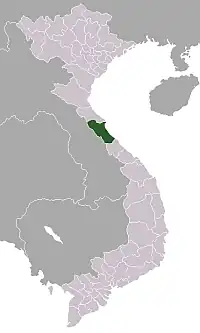源语
源语是一种在越南北中部的长山山脉和老挝的邻近地区由源族使用的越语支语言。
| 源语 | |
|---|---|
| / | |
| 发音 | /tʰjəŋ ŋwən/ |
| 母语国家和地区 | 越南、老挝 |
| 区域 | 广平省 |
| 族群 | 源族 |
母语使用人数 | 28,800-40,000 (2018)[1] |
| 語系 | 南亚语系
|
| 文字 | 拉丁字母(越南语字母) |
| 語言代碼 | |
| ISO 639-3 | nuo |
| Glottolog | nguo1239[2] |
| ELP | Nguôn |
 广平省的位置 | |
越南大多数源语使用者生活在偏僻的广平省明化县,其他则主要在宣化县首府同黎市镇周边距国道1号50 km(31 mi)以内的区域。
源语被认为是越南语的方言或芒语最南端的方言。一些认为其和芒语关系更近的研究者发现,那些认为源语和越南语关系更近的研究者受到了民族志研究或政治因素的影响。Chamberlain (2003)和Sidwell (2009)将其划作第三种越芒语支语言。
地理位置
大多数源族生活在宣化县(和相邻的使用哲语册方言的哲族共居)和明化县(与相邻的越族共居)。
也有生活在老挝的源语使用者,但其具体位置暂不明确。[3]据Chamberlain (1998),老挝中部甘蒙省布拉帕县班帕帕南村是一个源族村。[4]
归属
Chéon (1907)、Maspéro (1912)和Cuisinier (1948)认为源语和芒语关系更近,而莫唐(1964)、阮阳平(1975)和范德当(1975)将其和越南语关联。
随后由阮文才(1975)和阮复丰(1996)的语言比较认为源语和芒语方言的联系更紧密,这被Barker(1993)(以及其他人)重申。
艾杰瑞、Kenneth J. Gregerson和阮文雷注意到这种语言出于其独特的历时创新“对越语支语言历史研究者而言十分有趣”。[5]
阮文才(1975)注释道源语使用者可以和芒语使用者直接沟通,但不会芒语的越南语使用者则无法理解源语。
语言变体
阮复丰(1996)注释道源语有两种变体:
- 古廉
- 安寿
古廉来自其村名;安寿是新货村一个合作社的名字。
就特定的音位学变化而言,安寿方言比古廉方言更接近越南语。
历史
1905年Cadière[6]报告源语(及哲语册方言)在源能河谷的11个村庄中找到。[7]本来只有10个村庄各5个形成两组。北部方言群位于基沙州(混居一些越族村庄),包含下列村庄:
- 危达
- 安德
- 巴娘
- 青龙
- 新侨
新侨稍后分裂进第二个村庄:
- 新合
更南边的村庄群落包括
- 古廉
- 卜寿
- 金榜
- 新里
- 安洛
莫唐(1964)和阮阳平(1975)坚称源族本来是在17世纪从河静省和乂安省迁入其现居地的京族,支持这个假说的证据来自家谱。莫唐(1964)亦称大多数源族在1960年人口普查时自称越族。
阮文才(1975)认为芒族可能迁徙到比乂安省更靠南的广平省,一些京族家庭可能是从别处迁来这个区域的,这些京族迁来后逐渐改用芒语,这种芒语方言可能和哲语浊方言和册方言有过接触。因此阮文才(1975)认为源语是芒族使用的芒语方言(可能是河静芒语)并在来自哲语的影响下逐渐同化京族的过程中逐渐形成。[8]
注释
- . [2021-03-23]. (原始内容存档于2018-06-22).
- Hammarström, Harald; Forkel, Robert; Haspelmath, Martin; Bank, Sebastian (编). . . Jena: Max Planck Institute for the Science of Human History. 2016.
- See the Christian missionary site: Nguon people group of Laos 的存檔,存档日期2011-10-03..
- Chamberlain, J.R. 1998, "The origin of Sek: implications for Tai and Vietnamese history (页面存档备份,存于)", in The International Conference on Tai Studies, ed. S. Burusphat, Bangkok, Thailand, pp. 97-128. Institute of Language and Culture for Rural Development, Mahidol University.
- See their page on Lesser Known Languages of Northern Vietnam: ling.uta.edu/~jerry/research/ (页面存档备份,存于).
- The original French source is quoted in Nguyễn Ph. Ph. (1996).
- See the following satellite link from SatelliteViews.net: Nguồn Năn, Vietnam.
- In particular, see Nguyễn V. T. (1993: 242-243).
书目
- Barker, Miriam A. (1993). Bibliography of Mường and other Vietic language groups, with notes. Mon–Khmer Studies, 23, 197-243. (Online version: sealang.net/archives/mks/BARKERMiriam.htm (页面存档备份,存于)).
- Cadière, Léopold. (1902). Coutumes populaires de la vallée du Nguồn Sơn. Bulletin de l'École Française d'Extrême Orient, 2, 352-386.
- Cadière, Léopold. (1905). Les hautes vallées du sông Gianh. Bulletin de l'École Française d'Extrême Orient, 5, 349-367.
- Chamberlain, James R. (2003) Eco-Spatial History: a nomad myth from the Annamites and its Relevance for Biodiversity Conversation. In Landscapes of Diversity: indigenous knowledge, sustainable livelihoods and resource governance in Montane Mainland Southeast Asia., edited by X. Jianchu and S. Mikesell: Kunming Yunnan Science and Technology Press.
- Cuisinier, Jeanne. (1948). Les Mường: Géographie humaine et sociologie. Paris: Institut d'Ethnologie.
- 莫唐. (1964). Các dân tộc miền núi miền Bẳc Trung Bộ [The minority groups of Northern Central Vietnam]. Hanoi: Nhà x.b. Khoa học Xã hội.
- 阮阳平. (1975). Về thành phần dân tộc của người Nguồn [On the ethnic composition of the Nguon people]. In Viện Dân Tộc Học, Về vấn đề xác định thành phần các dân tộc thiểu số ở miền bắc Việt Nam (pp. 472–491). Hanoi: Nhà x.b. Khoa học Xã hội.
- 阮克颂 (1975). "Góp phần tim hiểu thành phần tộc người của người Nguồn qua những nhận xét về nhà ở của họ". In, Ủy ban khoa học xã hội Việt Nam: Viện dân tộc học. Về vấn đề xác định thánh phần các dân tộc thiểu số ở miền bắc Việt Nam, 492-499. Hà Nội: Nhà xuất bản khoa học xã hội.
- 阮复丰. (1996). The Nguồn language of Quảng Bình, Vietnam. Mon–Khmer Studies, 26, 179-190. (Online version: sealang.net/archives/mks/NGUYNPhPhong.htm (页面存档备份,存于)).
- 阮文才. (1975). Tiếng Nguồn, một phương tiếng Việt hay một phương ngôn của tiếng Mường? Ngôn Ngữ, 4, 8-16. (Translated into English as Nguyễn V. T. 1993).
- 阮文才. (1993). Nguồn: A dialect of Vietnamese or a dialect of Mường? (Based on local data). M. A. Barker (Transl.). Mon–Khmer Studies, 22, 231-244. (Online version: sealang.net/archives/mks/NGUYNVnTi.htm (页面存档备份,存于)).
- 范德当. (1975). Về mối quan hệ thân thuộc giữa các ngôn ngữ thuộc nhóm Việt-Mường miền Tây tỉnh Quảng Bình [On the close relationship between the languages in the Viet–Muong group in western Quảng Bình Province]. In Viện Dân Tộc Học, Về vấn đề xác định thành phần các dân tộc thiểu số ở miền bắc Việt Nam (pp. 500–517). Hanoi: Nhà x.b. Khoa học Xã hội.
- Sidwell, Paul. (2009) Classifying the Austroasiatic languages: history and state of the art (页面存档备份,存于). Lincom Europa.
- Viện Dân Tộc Học [Ethnology Institute]. (1975). Về vấn đề xác định thành phần các dân tộc thiểu số ở miền bắc Việt Nam [On the problem of defining the social position of the minority groups in northern Vietnam]. Hanoi: Nhà x.b. Khoa học Xã hội.